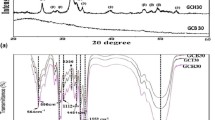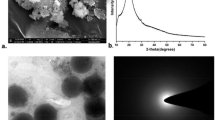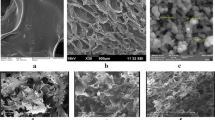Abstract
The chitosan-based hydrogel has high potential in tissue engineering; however, its performance is relatively poor in practice. Here, an easy method is introduced to produce high strength composite chitosan hydrogel. Chitosan (CS) and Basil seed gum (BSG) are converted into a 3-dimensional hydrogel with the assistance of Gallic acid (GA) as a cross-linking agent. The incorporation of GA into CS-BSG hydrogel forms cross-linking bonds (hydrogen bonds) between GA and polymer chains. The experimental results show that the GA cross-linked hydrogel has a dense microstructure, good mechanical properties, high porosity, thermal stability, and a high swelling ratio. With the high antioxidant activity and good biocompatibility, these properties make the GA-crosslinked hydrogel as a promising material for tissue engineering. Furthermore, adding quercetin loaded-Zein microsphere in the optimal hydrogel (the hydrogel containing the highest concentration of GA) proved to have a synergistic effect on the mentioned characteristics of the hydrogel. Cell culture tests confirmed that this scaffold is nontoxic and biocompatible for cell proliferation. The prepared hydrogels hold great potential as a scaffold for tissue engineering applications based on the results.















Similar content being viewed by others
References
Yi S, Ding F, Gong L, Gu X (2017) Extracellular matrix scaffolds for tissue engineering and regenerative medicine. Curr Stem Cell Res Ther 12:233–246. https://doi.org/10.2174/1574888x11666160905092513
Naahidi S, Jafari M, Logan M et al (2017) Biocompatibility of hydrogel-based scaffolds for tissue engineering applications. Biotechnol Adv 35:530–544. https://doi.org/10.1016/j.biotechadv.2017.05.006
Bai X, Gao M, Syed S et al (2018) Bioactive hydrogels for bone regeneration. Bioact Mater 3:401–417. https://doi.org/10.1016/j.bioactmat.2018.05.006
Xu Z, Li Z, Jiang S, Bratlie KM (2018) Chemically modified Gellan gum hydrogels with tunable properties for use as tissue engineering scaffolds. ACS Omega 3:6998–7007. https://doi.org/10.1021/acsomega.8b00683
Chai Q, Jiao Y, Yu X (2017) Hydrogels for biomedical applications: their characteristics and the mechanisms behind them. Gels. https://doi.org/10.3390/gels3010006
Moeini A, Pedram P, Makvandi P et al (2020) Wound healing and antimicrobial effect of active secondary metabolites in chitosan-based wound dressings: a review. Carbohydr Polym 233:115839. https://doi.org/10.1016/j.carbpol.2020.115839
Croisier F, Jérôme C (2013) Chitosan-based biomaterials for tissue engineering. Eur Polym J 49:780–792. https://doi.org/10.1016/j.eurpolymj.2012.12.009
Berger J, Reist M, Mayer JM et al (2004) Structure and interactions in chitosan hydrogels formed by complexation or aggregation for biomedical applications. Eur J Pharm Biopharm 57:35–52. https://doi.org/10.1016/S0939-6411(03)00160-7
Akrami-Hasan-Kohal M, Tayebi L, Ghorbani M (2020) Curcumin-loaded naturally-based nanofibers as active wound dressing mats: morphology, drug release, cell proliferation, and cell adhesion studies. New J Chem 44:10343–10351
Yavari L, Ghorbani M (2021) Injectable chitosan-quince seed gum hydrogels encapsulated with curcumin loaded-halloysite nanotubes designed for tissue engineering application. Int J Biol Macromol 177:485–494. https://doi.org/10.1016/j.ijbiomac.2021.02.113
Jing X, Mi HY, Napiwocki BN et al (2017) Mussel-inspired electroactive chitosan/graphene oxide composite hydrogel with rapid self-healing and recovery behavior for tissue engineering. Carbon N Y 125:557–570. https://doi.org/10.1016/j.carbon.2017.09.071
Bagher Z, Ehterami A, Safdel MH et al (2020) Wound healing with alginate/chitosan hydrogel containing hesperidin in rat model. J Drug Deliv Sci Technol 55:101379. https://doi.org/10.1016/j.jddst.2019.101379
Naji-Tabasi S, Razavi SMA (2017) Functional properties and applications of basil seed gum: an overview. Food Hydrocoll 73:313–325. https://doi.org/10.1016/j.foodhyd.2017.07.007
Tantiwatcharothai S, Prachayawarakorn J (2019) Characterization of an antibacterial wound dressing from basil seed (Ocimum basilicum L.) mucilage-ZnO nanocomposite. Int J Biol Macromol 135:133–140. https://doi.org/10.1016/j.ijbiomac.2019.05.118
Tantiwatcharothai S, Prachayawarakorn J (2020) Property improvement of antibacterial wound dressing from basil seed (O. basilicum L.) mucilage-ZnO nanocomposite by borax crosslinking. Carbohydr Polym 227:115360. https://doi.org/10.1016/j.carbpol.2019.115360
Aman Mohammadi M, Ramazani S, Rostami M et al (2019) Fabrication of food-grade nanofibers of whey protein isolate–guar gum using the electrospinning method. Food Hydrocoll 90:99–104. https://doi.org/10.1016/j.foodhyd.2018.12.010
Bam P, Bhatta A, Krishnamoorthy G (2019) Design of biostable scaffold based on collagen crosslinked by dialdehyde chitosan with presence of gallic acid. Int J Biol Macromol 130:836–844. https://doi.org/10.1016/j.ijbiomac.2019.03.017
Zhang X, Liu J, Qian C et al (2019) E ff ect of grafting method on the physical property and antioxidant potential of chitosan fi lm functionalized with gallic acid. Food Hydrocoll 89:1–10. https://doi.org/10.1016/j.foodhyd.2018.10.023
Thangavel P, Ramachandran B, Muthuvijayan V (2016) Fabrication of chitosan/gallic acid 3D microporous scaffold for tissue engineering applications. J Biomed Mater Res Part B Appl Biomater 104:750–760. https://doi.org/10.1002/jbm.b.33603
Khorsandi K, Kianmehr Z, Hosseinmardi Z, Hosseinzadeh R (2020) Anti-cancer effect of gallic acid in presence of low level laser irradiation: ROS production and induction of apoptosis and ferroptosis. Cancer Cell Int 20:1–14. https://doi.org/10.1186/s12935-020-1100-y
Zanwar AA, Badole SL, Shende PS et al (2013) Role of gallic acid in cardiovascular disorders. Elsevier, London
Wu Y, Sun J, George J et al (2016) Study of neuroprotective function of Ginkgo biloba extract (EGb761) derived-flavonoid monomers using a three-dimensional stem cell-derived neural model. Biotechnol Prog 32:735–744. https://doi.org/10.1002/btpr.2255
Pandey AK, Shukla SC, Bhattacharya P, Patnaik R (2016) A possible therapeutic potential of quercetin through inhibition of μ-calpain in hypoxia induced neuronal injury: a molecular dynamics simulation study. Neural Regen Res 11:1247–1253. https://doi.org/10.4103/1673-5374.189186
Min Q, Tan R, Zhang Y et al (2022) Multi-crosslinked strong and elastic bioglass/chitosan-cysteine hydrogels with controlled quercetin delivery for bone tissue engineering. Pharmaceutics. https://doi.org/10.3390/pharmaceutics14102048
Li Y, Yao J, Han C et al (2016) Quercetin, inflammation and immunity. Nutrients 8:1–14. https://doi.org/10.3390/nu8030167
Madani P, Hesaraki S, Saeedifar M, Ahmadi Nasab N (2022) The controlled release, bioactivity and osteogenic gene expression of Quercetin-loaded gelatin/tragacanth/nano-hydroxyapatite bone tissue engineering scaffold. J Biomater Sci Polym Ed. https://doi.org/10.1080/09205063.2022.2113293
Yadav S, Mehrotra GK, Bhartiya P et al (2020) Preparation, physicochemical and biological evaluation of quercetin based chitosan–gelatin film for food packaging. Carbohydr Polym 227:115348. https://doi.org/10.1016/j.carbpol.2019.115348
Rubini K, Boanini E, Menichetti A et al (2020) Food hydrocolloids Quercetin loaded gelatin films with modulated release and tailored anti-oxidant , mechanical and swelling properties. Food Hydrocoll 109:106089. https://doi.org/10.1016/j.foodhyd.2020.106089
Souza MP, Vaz AFM, Costa TB et al (2018) Construction of a biocompatible and antioxidant multilayer coating by layer-by-layer assembly of κ-carrageenan and quercetin nanoparticles. Food Bioprocess Technol 11:1050–1060
Zeinali M, Abbaspour-Ravasjani S, Ghorbani M et al (2020) Nanovehicles for co-delivery of anticancer agents. Drug Discov Today 25:1416–1430. https://doi.org/10.1016/j.drudis.2020.06.027
Mohammadi M, Mokarram RR, Ghorbani M, Hamishehkar H (2019) Inulinase immobilized gold-magnetic nanoparticles as a magnetically recyclable biocatalyst for facial and efficient inulin biotransformation to high fructose syrup. Int J Biol Macromol 123:846–855
Yavari L, Ghorbani M, Tabibiazar M et al (2021) Advanced properties of gelatin fi lm by incorporating modified kappa-carrageenan and zein nanoparticles for active food packaging. Int J Biol Macromol 183:753–759. https://doi.org/10.1016/j.ijbiomac.2021.04.163
Kasaai MR (2018) Zein and zein-based nano-materials for food and nutrition applications: a review. Trends Food Sci Technol 79:184–197. https://doi.org/10.1016/j.tifs.2018.07.015
Luo Y, Wang Q (2014) Zein-based micro- and nano-particles for drug and nutrient delivery: a review. J Appl Polym Sci 131:1–12. https://doi.org/10.1002/app.40696
Dong J, Sun Q, Wang JY (2004) Basic study of corn protein, zein, as a biomaterial in tissue engineering, surface morphology and biocompatibility. Biomaterials 25:4691–4697. https://doi.org/10.1016/j.biomaterials.2003.10.084
Tu J, Wang H, Li H et al (2009) The in vivo bone formation by mesenchymal stem cells in zein scaffolds. Biomaterials 30:4369–4376. https://doi.org/10.1016/j.biomaterials.2009.04.054
Qu ZH, Wang HJ, Tang TT et al (2008) Evaluation of the zein/inorganics composite on biocompatibility and osteoblastic differentiation. Acta Biomater 4:1360–1368. https://doi.org/10.1016/j.actbio.2008.03.006
Murdan S (2005) Formulation and characterisation of zein microspheres as delivery vehicles. J Drug Deliv Sci Technol 15:267–272. https://doi.org/10.1016/S1773-2247(05)50048-0
Aman Mohammadi M, Ramezani S, Hosseini H et al (2021) Electrospun antibacterial and antioxidant zein/polylactic acid/hydroxypropyl methylcellulose nanofibers as an active food packaging system. Food Bioprocess Technol. https://doi.org/10.1007/s11947-021-02654-7
Xie Y, Liao X, Zhang J et al (2018) Novel chitosan hydrogels reinforced by silver nanoparticles with ultrahigh mechanical and high antibacterial properties for accelerating wound healing. Int J Biol Macromol 119:402–412. https://doi.org/10.1016/j.ijbiomac.2018.07.060
Sabzichi M, Mohammadian J, Ghorbani M et al (2017) Fabrication of all-trans-retinoic acid-loaded biocompatible precirol: a strategy for escaping dose-dependent side effects of doxorubicin. Colloids Surfaces B Biointerfaces 159:620–628. https://doi.org/10.1016/j.colsurfb.2017.08.030
Raeisi S, Chavoshi H, Mohammadi M et al (2019) Naringenin-loaded nano-structured lipid carrier fortifies oxaliplatin-dependent apoptosis in HT-29 cell line. Process Biochem 83:168–175. https://doi.org/10.1016/j.procbio.2019.05.013
Ghorbani M, Mahmoodzadeh F, Yavari Maroufi L, Nezhad-Mokhtari P (2020) Electrospun tetracycline hydrochloride loaded zein/gum tragacanth/poly lactic acid nanofibers for biomedical application. Int J Biol Macromol 165:1312–1322. https://doi.org/10.1016/j.ijbiomac.2020.09.225
Ghorbani M, Hamishehkar H, Arsalani N, Entezami AA (2016) Surface decoration of magnetic nanoparticles with folate-conjugated poly(N-isopropylacrylamide-co-itaconic acid): a facial synthesis of dual-responsive nanocarrier for targeted delivery of doxorubicin. Int J Polym Mater Polym Biomater 65:683–694. https://doi.org/10.1080/00914037.2016.1157800
Maroufi NF, Vahedian V, Mazrakhondi SAM et al (2020) Sensitization of MDA-MBA231 breast cancer cell to docetaxel by myricetin loaded into biocompatible lipid nanoparticles via sub-G1 cell cycle arrest mechanism. Naunyn Schmiedebergs Arch Pharmacol 393:1–11
Ghorbani M, Hamishehkar H, Hajipour H et al (2016) Ternary-responsive magnetic nanocarriers for targeted delivery of thiol-containing anticancer drugs. New J Chem 40:3561–3570. https://doi.org/10.1039/C5NJ03602J
Akrami-Hasan-Kohal M, Ghorbani M, Mahmoodzadeh F, Nikzad B (2020) Development of reinforced aldehyde-modified kappa-carrageenan/gelatin film by incorporation of halloysite nanotubes for biomedical applications. Int J Biol Macromol 160:669–676
Yavari L, Tabibiazar M, Ghorbani M, Jahanban-esfahlan A (2021) Fabrication and characterization of novel antibacterial chitosan/dialdehyde guar gum hydrogels containing pomegranate peel extract for active food packaging application. Int J Biol Macromol 187:179–188. https://doi.org/10.1016/j.ijbiomac.2021.07.126
Khazaei N, Esmaiili M, Djomeh ZE et al (2014) Characterization of new biodegradable edible film made from basil seed (Ocimum basilicum L.) gum. Carbohydr Polym 102:199–206. https://doi.org/10.1016/j.carbpol.2013.10.062
Khaskheli AR, Naz S, Ozul F et al (2016) Urchin-like cobalt nanostructures for catalytic degradation of nitro anilines. Adv Mater Lett. https://doi.org/10.5185/amlett.2016.6264
Karthikeyan K, Vijayalakshmi E, Korrapati PS (2014) Selective interactions of zein microspheres with different class of drugs: an in vitro and in silico analysis. AAPS PharmSciTech 15:1172–1180. https://doi.org/10.1208/s12249-014-0151-6
Luigi C (2015) Silica/quercetin sol–gel hybrids as antioxidant dental implant materials. My IOP Sci. https://doi.org/10.1088/1468-6996/16/3/035001
He X, Liu X, Yang J et al (2020) Tannic acid-reinforced methacrylated chitosan/methacrylated silk fibroin hydrogels with multifunctionality for accelerating wound healing. Carbohydr Polym 247:116689. https://doi.org/10.1016/j.carbpol.2020.116689
Stefanov I, Hinojosa-caballero D, Maspoch S (2018) Enzymatic synthesis of a thiolated chitosan-based wound dressing crosslinked with chicoric acid. J Mater Chem 7943–7953. https://doi.org/10.1039/c8tb02483a
Doustdar F, Olad A, Ghorbani M (2022) Development of a novel reinforced scaffold based on chitosan/cellulose nanocrystals/halloysite nanotubes for curcumin delivery. Carbohydr Polym 282:119127. https://doi.org/10.1016/j.carbpol.2022.119127
Ghorbani M, Roshangar L, Soleimani J (2020) Development of reinforced chitosan/pectin scaff old by using the cellulose nanocrystals as nano fillers: an injectable hydrogel for tissue engineering. Eur Polym J 130:109697. https://doi.org/10.1016/j.eurpolymj.2020.109697
Zhao Y, Sun Z (2018) Effects of gelatin-polyphenol and gelatin–genipin cross-linking on the structure of gelatin hydrogels. Int J Food Prop 20:S2822–S2832. https://doi.org/10.1080/10942912.2017.1381111
Bissoyi A, Kumar Singh A, Kumar Pattanayak S et al (2017) Understanding the molecular mechanism of improved proliferation and osteogenic potential of human mesenchymal stem cells grown on a polyelectrolyte complex derived from non-mulberry silk fibroin and chitosan. Biomed Mater 13:015011. https://doi.org/10.1088/1748-605X/aa890c
Morgan AW, Roskov KE, Lin-Gibson S et al (2008) Characterization and optimization of RGD-containing silk blends to support osteoblastic differentiation. Biomaterials 29:2556–2563. https://doi.org/10.1016/j.biomaterials.2008.02.007
Chaudhuri O, Gu L, Klumpers D et al (2016) Hydrogels with tunable stress relaxation regulate stem cell fate and activity. Nat Mater 15:326–334. https://doi.org/10.1038/nmat4489.Hydrogels
Rubentheren V, Ward TA, Yern C, Kuang C (2015) Processing and analysis of chitosan nanocomposites reinforced with chitin whiskers and tannic acid as a crosslinker. Carbohydr Polym 115:379–387. https://doi.org/10.1016/j.carbpol.2014.09.007
Thanyacharoen T, Chuysinuan P, Techasakul S et al (2018) Development of a gallic acid-loaded chitosan and polyvinyl alcohol hydrogel composite: release characteristics and antioxidant activity. Int J Biol Macromol 107:363–370. https://doi.org/10.1016/j.ijbiomac.2017.09.002
Talón E, Trifkovic KT, Nedovic VA et al (2016) Polyphenols from thyme extracts. Carbohydr Polym. https://doi.org/10.1016/j.carbpol.2016.10.080
Doustdar F, Ghorbani M (2022) ZIF-8 enriched electrospun ethyl cellulose/polyvinylpyrrolidone scaffolds: the key role of polyvinylpyrrolidone molecular weight. Carbohydr Polym 291:119620. https://doi.org/10.1016/j.carbpol.2022.119620
Zhou Y, Wu Y, Ma W et al (2017) The effect of quercetin delivery system on osteogenesis and angiogenesis under osteoporotic conditions. J Mater Chem B 5:612–625
Mahindrakar KV, Rathod VK (2020) Ultrasonic assisted aqueous extraction of catechin and gallic acid from Syzygium cumini seed kernel and evaluation of total phenolic, flavonoid contents and antioxidant activity. Chem Eng Process Process Intensif 149:107841. https://doi.org/10.1016/j.cep.2020.107841
Lu Z, Nie G, Belton PS et al (2006) Structure-activity relationship analysis of antioxidant ability and neuroprotective effect of gallic acid derivatives. Neurochem Int 48:263–274. https://doi.org/10.1016/j.neuint.2005.10.010
Nagpal I, Abraham SK (2017) Ameliorative effects of gallic acid, quercetin and limonene on urethane-induced genotoxicity and oxidative stress in Drosophila melanogaster. Toxicol Mech Methods 27:286–292. https://doi.org/10.1080/15376516.2016.1278294
Giordani B, Basnet P, Mishchenko E et al (2020) Utilizing liposomal quercetin and gallic acid in localized treatment of vaginal Candida infections. Pharmaceutics 12:1–21. https://doi.org/10.3390/pharmaceutics12010009
Abarikwu SO, Simple G, Onuoha CS (2020) Morphometric evaluation of the seminiferous tubules and the antioxidant protective effects of gallic acid and quercetin in the testis and liver of butyl phthalate treated rats. Indian J Clin Biochem 35:20–31. https://doi.org/10.1007/s12291-018-0788-0
Bernini R, Puglia D (2019) Gallic acid and quercetin as intelligent and active ingredients in poly(vinyl alcohol) films for food packaging. Polymers 11:1999
Stoyanova N, Spasova M, Manolova N et al (2020) Antioxidant and antitumor activities of novel quercetin-loaded electrospun cellulose acetate/polyethylene glycol fibrous materials. Antioxidants 9:1–16. https://doi.org/10.3390/antiox9030232
Pîrvu L, Sha’at FS, Miclea LȚAC et al (2017) Polygonum bistorta L. herba et flores. Polyphenols profile , antioxidant properties and cytotoxic effect on murine fibroblast cell line NIH3T3. Farmacia 65:2–7
Kumar A, Kumar S, Chand U (2014) Quercetin and gallic acid mediated synthesis of bimetallic (silver and selenium) nanoparticles and their antitumor and antimicrobial potential. J Colloid Interface Sci 431:194–199. https://doi.org/10.1016/j.jcis.2014.06.030
Young E, Huh J, Choi M, Young S (2008) Inhibitory effects of gallic acid and quercetin on UDP-glucose dehydrogenase activity. FEBS Lett 582:3793–3797. https://doi.org/10.1016/j.febslet.2008.10.010
Mohebian Z, Yavari Maroufi L, Ghorbani M (2021) Development of a novel reinforced film based on gellan gum/cellulose nanofiber/soy protein for skin tissue engineering application. New J Chem 45:13814–13821. https://doi.org/10.1039/d1nj02623b
Golafshan N, Rezahasani R, Tarkesh Esfahani M et al (2017) Nanohybrid hydrogels of laponite: PVA-alginate as a potential wound healing material. Elsevier, London
Ghorbani M, Hamishehkar H (2017) Redox and pH-responsive gold nanoparticles as a new platform for simultaneous triple anti-cancer drugs targeting. Int J Pharm 520:126–138. https://doi.org/10.1016/j.ijpharm.2017.02.008
Amjadi S, Almasi H, Ghorbani M, Ramazani S (2020) Reinforced ZnONPs/rosemary essential oil-incorporated zein electrospun nano fi bers by κ-carrageenan. Carbohydr Polym 232:115800. https://doi.org/10.1016/j.carbpol.2019.115800
Acknowledgements
The authors are thankful to the Nutrition Research Center, Tabriz University of Medical Sciences, Tabriz, Iran (68391) for supported present study.
Funding
The authors have not disclosed any funding.
Author information
Authors and Affiliations
Contributions
MHA-M: Writing—original draft, Methodology, Investigation. MR: Data Curation, review and editing, Formal analysis. VM: Data curation, Formal analysis, Methodology. SA: Review and editing, Formal analysis. EM: Review and editing, Formal analysis, Methodology. MG: Project administration, Conceptualization, Data curation, Supervision, Funding acquisition, review and editing, Formal analysis.
Corresponding author
Ethics declarations
Conflict of interest
The authors have not disclosed any conflict of interest.
Additional information
Publisher's Note
Springer Nature remains neutral with regard to jurisdictional claims in published maps and institutional affiliations.
Rights and permissions
Springer Nature or its licensor (e.g. a society or other partner) holds exclusive rights to this article under a publishing agreement with the author(s) or other rightsholder(s); author self-archiving of the accepted manuscript version of this article is solely governed by the terms of such publishing agreement and applicable law.
About this article
Cite this article
Al-Musawi, M.H., Rashidi, M., Mohammadzadeh, V. et al. Development of a Novel Scaffold Based on Basil Seed Gum/Chitosan Hydrogel Containing Quercetin-Loaded Zein Microshphere for Bone Tissue Engineering. J Polym Environ 31, 4738–4751 (2023). https://doi.org/10.1007/s10924-023-02913-y
Accepted:
Published:
Issue Date:
DOI: https://doi.org/10.1007/s10924-023-02913-y




